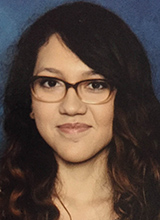PREP Alumni
Browse below to meet the alumni of the Northwestern University Postbaccalaureate Research Education Program (NU PREP).


Faith Adams
Undergraduate: Farleigh Dickinson University - Biochemistry
Mentor: Talia Lerner
Research Project Description:
My current research focuses on investigating the effect of early life stress (ELS) on dopamine learning signals in adulthood. ELS disrupts the development of neuronal circuits, imposing an increased risk for the development of neuropsychiatric diseases such as anxiety disorders, mood disorders, and substance abuse disorders. Considering the role of midbrain dopamine neurons in motivated behaviors, I will be investigating the effect of ELS on midbrain dopamine neuron anatomical circuitry in adulthood using rabies-mediated viral tracing and tissue clearing (SHIELD).

Hawa Adaweh
Undergraduate: Virginia Tech University - Cognitive and Behavioral Neuroscience and Psychology
Mentor: Ken Paller
Research Project Description:
My research focus revolves around cognitive and behavioral/clinical neuroscience. Ideally, I want to look into how certain beneficial drugs affect the symptoms/cognition of neuropsychiatric illnesses. I'm hoping to use neuroimaging techniques as well as behavioral methods for this specific research interest. I am also interested in learning and memory as well as sleeping patterns during lucid dreaming and the significance of the brain waves.
Saul Bello Rojas
Undergraduate: Lake Forest College - Neuroscience
Mentor: David McLean
Research Project Description:
The primary focus of my research is identifying the morphological differences and function in motor neuron spinal axon collaterals in zebrafish. Previously, I worked on understanding protein mutations in diseases like Parkinson’s and Age-related Macular degeneration in yeast and mice, respectively. I have an interest in understanding motor circuitry and the complex motor network in the spinal cord initiates movement.

Alex Benedetto
Undergraduate: Pennsylvania State University - Biology
Mentor: Matt Tresch
Research Project Description:
The Tresch lab is currently working to develop a cortically controlled functional electrical stimulation system for spinal cord injury rehabilitation using the rat model. As a part of that project, I am using a video recording system and DeepLabCut to monitor behavior changes in the rats after they have been chronically implanted with epidural electrodes.
Todd Blakely Jr
Undergraduate: University of Puget Sound - Biochemistry
Mentor: Rajeshwar Awatramani
Research Project Description:
My project in the Awatramani lab explores the epigenetic regulation necessary for proper nerve regeneration. I focus on specific genes, Sox6 and Sonic Hedgehog, required to inhibit myelination in the Schwann cell repair program, which is crucial to nerve regeneration. Our goal is to identify a therapeutic target within the Schwann cell repair program.
Donnisa Edmonds
Undergraduate: University of Pennsylvania - Neuroscience
Mentor: Thorsten Kahnt
Research Project Description:
I am currently interested in the neural processes that underly decision making and how neuroimaging can be used to enhance our understanding of these neural systems. My current project explores how activity in the midbrain and OFC shape associative learning in the context of identity prediction errors.
Sarah Etuk
Undergraduate: Pomona College - Neuroscience
Mentor: Robin Nusslock
Research Project Description:
I am interested in using structural and functional neuroimaging techniques to understand the neural mechanisms involved in the development of mood and anxiety disorders. I’ve newly begun working on a project that explores how threat and reward neural circuitry might account for associations found between stress and the gut microbiome. As an undergraduate, I completed a senior undergraduate thesis that investigated the relation between perceived discrimination and the cortisol awakening response in black women.

Andrew Fleming
Undergraduate: The Ohio State University - Neuroscience
Mentor: John Kessler
Research Project Description:
My current research interests center on glia cells. More specifically, astrocytes. Astrocytes are commonly thought of as simply a support structure for their surrounding neurons, but recent investigations suggest they have an even more profound effect on the central nervous system. Furthermore, I am interested in the interactions of the endothelium, basement membrane proteins, and glial cells and how they are all involved in the formation of the blood brain barrier. Glial cells are vital to the formation of the tight junctions in the endothelium, but the mechanisms by which this occurs is still unclear. I hope to uncover more about this process as it relates to a number of CNS vascular pathologies.

Molishka Flores-Narvaez
Undergraduate: Pontifical Catholic University of Puerto Rico - Biomedical Sciences
Mentor: Marco Gallio
Research Project Description:
As an undergraduate student I had the opportunity to work in a Neuroscience lab that focused in studying therapeutic alternatives for neurodegenerative diseases. This experience made me realize my interest in studying the neural mechanisms that determine animal behavior. Now being part of NUIN-PREP and as a member of the Gallio Lab my research centers on using the dynamic genetic model Drosophila to understand the molecular and cellular underpinnings of thermosensation and how it evolves across species. My goal is to uncover what factors contribute to the evolution of thermosensation in order to understand how sensory processing evolves

Abby Galvez
Undergraduate: Cornell University - Psychology
Mentor: John Disterhoft
Research Project Description:
My research has centered on using biochemical techniques to study neuronal and behavioral changes in response to differential experiences in early development. Recently, I contributed to research that investigated the effects of single-parent family units on prosocial and aggressive behavior. I hope to continue this line of research with a focus on the role early life stress and trauma have on the development of neurobiological and/or neuropsychiatric disorders at a later point.
Kathy Garcia
Undergraduate: Stanford University - Science, Technology, and Society
Mentor: Robin Nusslock
Research Project Description:
I am investigating the relationship between different models of psychopathology to understand neurobiological/neuropsychiatric diseases. More specifically, my current work focuses on how clinical disorders may manifest in altered patterns of functional connectivity between various brains.
Camille Guzman
Undergraduate: Northwestern University - Biomedical Engineering
Mentor: Matthew Tresch
Research Project Description:
My research interests involve developing new treatments and neuroprosthetic technologies to improve motor function in individuals following a stroke or spinal cord injury. My previous research experiences involved assessing perceptual deficits in individuals following a hemiparetic stroke, as well as limb control and gait patterns in transtibial prosthesis users. I hope to research neural engineering mechanisms and technologies in graduate school to help restore motor function in individuals with motor impairments.
Reem Ibrahim
Undergraduate: Smith College - Biomedical Engineering
Mentor: Mitra Hartmann
Research Project Description:
We're interested in how the brain processes touch. Rats use their sense of touch through a rhythmic motion called “whisking” to explore their environment. There is a lack of methodology in the field for studying rat whisker contact durations with various objects during natural behavior. To bridge that gap, we are investigating which whiskers are most likely to exhibit sustained contact during whisking, and examine the consequences if they did not sustain contact.
Jarildy Javier
Undergraduate: Colby College - Biology
Mentor: Tiffany Schmidt
Research Project Description:
As a senior at Colby, I was offered the opportunity to work in a behavioral neuropsychology lab as a research assistant. The lab focused mainly on choline and its effects throughout life, as well as its neuroprotective properties against psychological disorders, but I was also exposed to models of addiction, mild traumatic brain injury and postpartum depression. Though late in my college career, this exposure propelled me toward further exploration of neuroscience and its connection to behavior. Through the NU IN-PREP Postbac program, I am currently in the Schmidt Lab in Evanston learning about and working with a group of key players in visual processing: intrinsically photosensitive retinal ganglion cells (ipRGCs). My goal is to reveal more about how ipRGCs contribute to visual processing so that we can better understand the increasingly complex system that is vision.

Andres Lira
Undergraduate: University of California, Davies - Biochemistry and Molecular Biology
Mentor: Gabriel Rocklin
Research Project Description:
My research involves protein-display stability assay to benchmark computational ab initio models and improve protein stability prediction for Rosetta. I plan on using Rosetta to engineer proteins in my PhD program and beyond.
Yasmeen Lowe
Undergraduate: DePaul University - Neuroscience
Mentor: Genia Kozorovitskiy
Research Project Description:
My previous research trainings have primarily been in analyzing behavior as a method of determining the effects of environmental contaminants on neurodevelopment and mental health Currently my research consists of examining the neural circuitry of neuromodulators in the medial prefrontal cortex. However, I am interested in understanding the impact early life stressors, specifically immune challenges, have on neurodevelopment and mental health through both behavioral and cellular methods.
Kayla Miguel
Undergraduate: University of Miami - Neuroscience
Mentor: Tom Bozza
Research Project Description:
I am researching a small family of odorant receptors called the trace amine-associated receptors or TAARs. I am trying to understand how the TAARs play a role in the perception of odors and the detection of social cues in mice.

Madaline Mocchi
Undergraduate: Grinnell College - Psychology
Mentor: Eva Redei
Research Project Description:
My current research interests center on understanding how genetics and the environment interact to produce anxious and depressive behaviors in adulthood. Specifically, I am investigating how two Wistar-Kyoto (WKY) rat sub strains behave in adulthood after exposure to an acute stressor in adolescence, and the expression of genes corresponding to those behaviors. In the future, I also hope to study the interaction between thyroid hormone levels and environmental stressors in the development of various psychopathologies.

Chad Morton
Undergraduate: Southern Connecticut State University - Chemistry
Mentor: Anis Contractor
Research Project Description:
Recently, I’ve been focused on clarifying the precise molecular mechanisms of synaptic communication in fragile X syndrome (FXS). More specifically, my research involves identifying which receptors and ion channels contribute to metaplasticity and how they are altered in FXS. Previously, my research experiences comprised of the use of stem cell therapy in parkinsonian disease models, neurodegeneration in spinal injury, hydroboration facilitated chemical synthesis of novel compounds and nuclear imaging research involving the diagnoses, understanding, and discovery of new therapies for CNS disorders. I have an interest in the molecular mechanisms governing learning and memory and neurodegenerative diseases and endeavor to continue doing research in those fields.

Matias Murillo
Undergraduate: Western New Mexico University - B.S. in Cell and Molecular Biology
Mentor: Colin Franz
Research Project Description:
My current research involves looking at the potential of graphene scaffolds to promote faster axon regeneration and modeling formation of the Neuromuscular Junction (NMJ) in-vitro via microfluidic devices using motor neurons and myotubes in 2D cells and 3D spheroid cultures. My lab is also modeling spinal cord injury (SCI) and traumatic brain injury (TBI) by inflicting stretch injury to cortical neurons or motor neurons derived from iPSCs from patients with the Val66Met BDNF polymorphism.
Nkatha Mwenda
Undergraduate: Kalamazoo College - Biology
Mentor: Raj Awatramani
Research Project Description:
My previous research experience focused on identification and development of new therapeutic targets for treatment of age-related diseases using bioanalytical chemistry. Through this work I became interested in the molecular pathology of age-related diseases and specifically neurodegenerative diseases. In the future, I hope to further explore my interests in molecular neurobiology through research centered around the molecular mechanisms of various diseases.

Luzivette Robles
Undergraduate: University of Puerto Rico, Rio Piedras - Cellular and Molecular Biology
Mentor: Liming Li
Research Project Description:
My project uses yeast models, which express either neurodegeneration proteins or prion proteins, to screen various compounds for inhibiting aggregation and toxicity. I measure yeast cell growth and protein aggregation to determine the effectiveness of the different compounds. Identifying compounds that both inhibit or eliminate prions and neurodegenerative proteins could help explain the molecular mechanisms through which they propagate.

Sierra Smith
Undergraduate: Lake Forest College - Neuroscience
Mentor: Raj Awatramani
Research Project Description:
My last research experience focused on Alzheimers Disease and the involvement of calcium release in the affected neurons. I used specific inhibitors of a Ryanodine receptor and measured differing levels of calcium release. Currently, I am focused on Parkinson’s Disease and am investigating potential compensatory mechanisms in several mouse models of Dopamine depletion. In the future I am interested in pursuing the molecular mechanisms of other diseases both neurodegenerative and non-neurodegenerative.

Toneisha Stubbs
Undergraduate: Kenyon College - Neuroscience
Mentor: Murali Prakriya
Research Project Description:
My research experience in undergrad involved studying the effect of a GABA A antagonist on object recognition memory in a mouse model for autism. My behavioral work led to my interest in molecular neuroscience particularly the function of ion channels.

Leah Vinson
Undergraduate: Northwestern University - Neuroscience
Mentor: John Disterhoft
Research Project Description:
Currently, I am investigating learning and memory mechanisms involving the somatosensory cortex in mice. Extensive research conducted on the primary somatosensory cortex has revealed that it is necessary for the acquisition but not retention of whisker-signaled trace eyeblink conditioning, a declarative memory task. Preliminary experiments conducted in the Disterhoft laboratory suggest that the secondary somatosensory cortex mediates the storage of whisker-evoked memories. Hence, the objective of my project is to determine if the secondary somatosensory cortex is a necessary part of the engram for whisker-evoked memories. Using trace eyeblink conditioning, mice are trained to associate whisker vibration with an airpuff directed at the eye to elicit a blink response. The mice eventually exhibit blinks in response to whisker vibration prior to the onset of the airpuff. This conditioned response is our assay for learning. Using Designer Receptors Exclusively Activated by Designer Drugs or DREADDs and our well-controlled behavioral task, I will investigate the necessity of the somatosensory cortex and its different subareas in mediating the acquisition and storage of long-term memories.

Josset Yarbrough
Undergraduate: University of California, Santa Cruz - Neuroscience
Mentor: Anis Contractor
Research Project Description:
My prior research experience explored mitochondrial transport in drosophila models expressing proteins linked to Alzheimer's disease (Tau, AB, and Appl). My current research interests revolve around understanding the mechanisms underlying memory and motor recovery in stroke patients and patients with neurodegenerative illnesses.

Taylor Zuleger
Undergraduate: University of Wisconsin, Green Bay - Human Biology and Psychology
Mentor: Arun Jayaraman
Research Project Description:
My research training and experience has predominantly involved the use of brain imaging (EEG) to understand the neural underpinnings of moral and prosocial development in preschool-aged children. I have since come to appreciate the neural substrates of mental processes and the study of cognitive differences associated with motor systems and motor learning. My hope is to expand my knowledge and explore the techniques associated with motor performance across an array of neurological insults.
